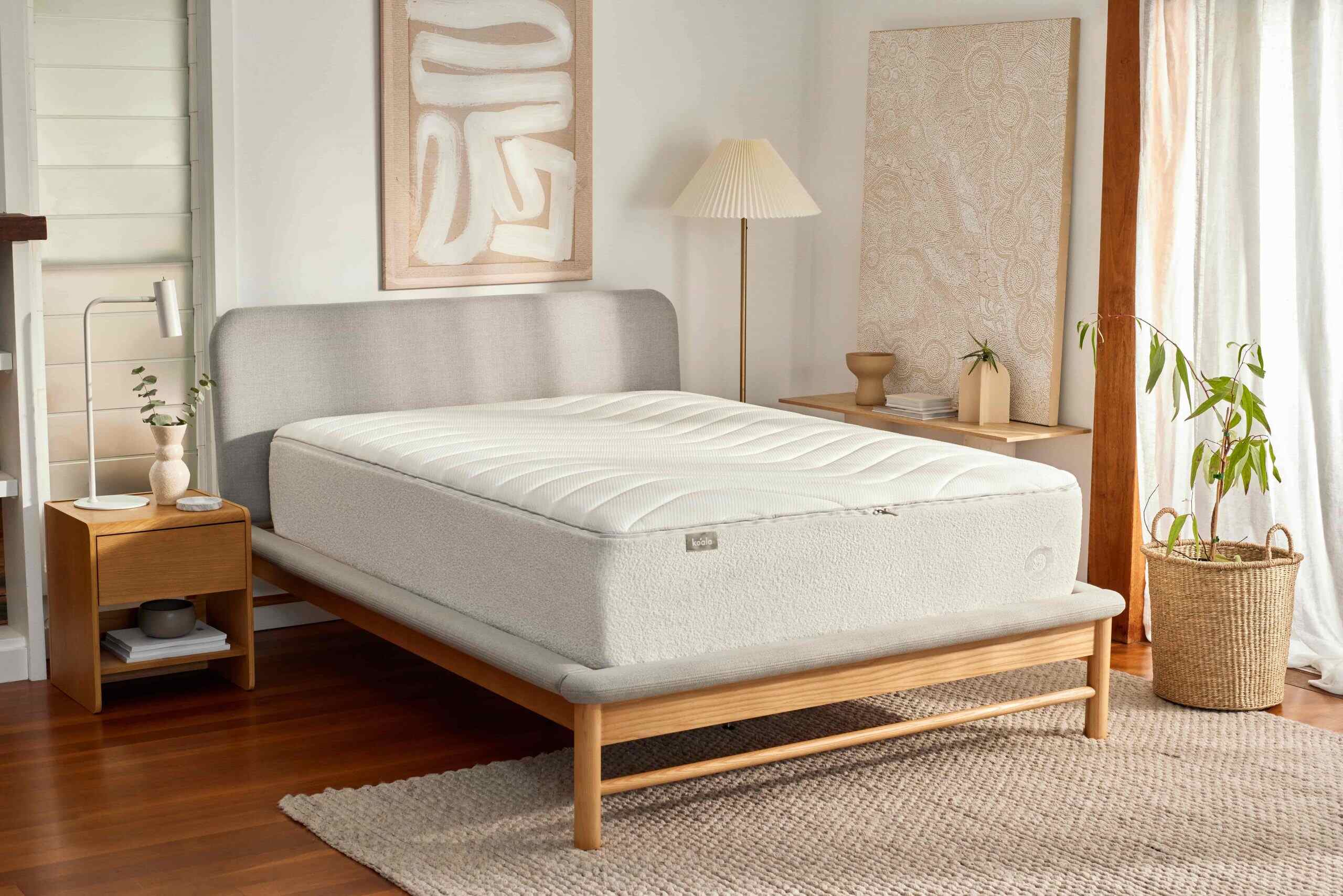Home>Furniture>Bedroom Furniture>When To Rotate A Mattress


Bedroom Furniture
When To Rotate A Mattress
Modified: January 9, 2024
Find out when is the right time to rotate your mattress for maximum comfort and longevity. Explore our collection of bedroom furniture for ultimate relaxation.
(Many of the links in this article redirect to a specific reviewed product. Your purchase of these products through affiliate links helps to generate commission for Storables.com, at no extra cost. Learn more)
Introduction
Welcome to the world of bedroom furniture! A key component of any bedroom is the mattress, as it plays a vital role in ensuring a good night’s sleep. However, over time, even the best mattresses can start to show signs of wear and tear. That’s where mattress rotation comes into play.
Mattress rotation is the process of flipping or turning a mattress to distribute the wear evenly. This simple maintenance task can help prolong the lifespan of your mattress and ensure optimal comfort and support. In this article, we will explore the signs that indicate your mattress needs rotation, the benefits of rotating your mattress, how often you should perform this task, and specific guidelines for different mattress types.
So, let’s dive in and discover when it’s time to rotate your mattress and why it’s an essential part of mattress care.
Key Takeaways:
- Regularly rotating your mattress can prevent sagging, improve comfort, and extend its lifespan, leading to cost savings and a healthier sleep environment.
- Keep an eye out for signs of wear like sagging, visible indentations, and discomfort to determine when it’s time to rotate your mattress for optimal support and sleep quality.
Read more: When Should You Rotate Your Mattress
Signs of Mattress Wear
It’s important to keep an eye out for the telltale signs that your mattress is starting to wear out. By recognizing these signs early on, you can take the necessary steps to maintain the longevity and comfort of your mattress. Here are some common signs of mattress wear:
- Sagging: One of the most noticeable signs of wear is when your mattress starts to sag. You may notice a visible dip or indentation in the middle or along the edges of the mattress. This can often happen due to the weight of your body over time, or if the mattress is of poor quality.
- Visible indentations: Another sign of wear is the presence of visible indentations on the surface of the mattress. If you can see the shape of your body imprinted on the mattress, it’s a clear indication that it’s time for a rotation.
- Uneven firmness: As mattresses age, they may lose their initial firmness, leading to an uneven sleeping surface. If you notice that certain areas feel softer or firmer than others, it’s a clear sign that your mattress needs to be rotated.
- Lumpy or bumpy feel: Over time, the padding and materials inside a mattress can shift, resulting in a lumpy or bumpy feel. This can greatly impact your comfort and quality of sleep.
- Increased discomfort or pain: If you’re waking up with increased discomfort or pain, especially in your back, neck, or joints, it may be due to the wear and tear of your mattress. Rotating the mattress can help alleviate these issues by providing better support and pressure relief.
By regularly inspecting your mattress for these signs of wear, you can determine when it’s time to rotate it and prevent further deterioration. Remember, a well-maintained mattress not only improves your sleep quality but also ensures a healthier and more comfortable sleeping environment.
Benefits of Rotating a Mattress
Mattress rotation offers a range of benefits that help extend the lifespan and optimize the performance of your mattress. Here are some key advantages of regularly rotating your mattress:
- Even Wear Distribution: By rotating your mattress, you ensure that the wear and tear are distributed evenly across the entire surface. This helps prevent the formation of permanent indentations in specific areas, prolonging the lifespan of your mattress.
- Enhanced Comfort: Over time, mattresses can develop body impressions and lose their initial firmness. By rotating your mattress, you can restore a more balanced sleeping surface, reducing discomfort and providing a more comfortable sleep experience.
- Improved Support: Mattress rotation helps maintain the integrity and support of the mattress. By redistributing the weight and pressure placed on the mattress, you can ensure that it continues to provide optimal support for your body, reducing the risk of body aches and pains.
- Prevention of Dust Mites and Allergens: Dust mites and allergens can accumulate in mattresses over time, leading to potential health issues. Regularly rotating and flipping your mattress can help reduce the buildup of these allergens, creating a cleaner and healthier sleep environment.
- Cost Savings: By properly maintaining your mattress through rotation, you can extend its lifespan and delay the need for a replacement. This can result in significant cost savings in the long run, as mattresses can be a substantial investment.
Overall, mattress rotation is a simple yet effective maintenance task that can have a significant impact on the durability, comfort, and support of your mattress. By incorporating regular rotation into your mattress care routine, you can ensure a more comfortable and restful sleep, while also getting the most out of your investment.
How Often Should You Rotate Your Mattress?
The frequency at which you should rotate your mattress depends on several factors, including the type of mattress you have and your individual sleep habits. Here are some general guidelines to help you determine how often you should rotate your mattress:
- Innerspring Mattress: Innerspring mattresses typically benefit from being rotated every three to six months. This helps to evenly distribute the weight and pressure on the springs, preventing sagging and extending the lifespan of the mattress.
- Memory Foam Mattress: Memory foam mattresses do not require flipping, but they can still benefit from rotation. It’s recommended to rotate a memory foam mattress once or twice a year to ensure even wear and maintain its supportive properties.
- Hybrid Mattress: Hybrid mattresses, which combine innerspring coils with memory foam or latex, should be rotated every three to six months. This allows for even compression of the springs and helps prevent the development of body impressions.
- Latek Mattress: Latex mattresses are known for their durability and resilience. While they don’t need to be rotated as frequently as other mattress types, it’s still beneficial to rotate them every six to twelve months to promote even wear and maintain their supportive properties.
- Pillow Top Mattress: Pillow top mattresses have a comfortable layer of cushioning on top, which can develop body impressions over time. To prevent these impressions from becoming permanent, it’s advisable to rotate your pillow top mattress every three to six months.
However, it’s essential to consider your individual sleep patterns and adjust the rotation frequency accordingly. If you notice significant sagging, discomfort, or uneven wear before the recommended time frame, it may be beneficial to rotate your mattress more frequently.
Ultimately, the goal is to ensure that your mattress wears evenly and maintains its comfort and support throughout its lifespan. Regularly rotating your mattress is a simple yet effective way to achieve this and maximize the longevity of your investment in quality sleep.
Rotate your mattress every 3-6 months to promote even wear and extend its lifespan. This can help prevent sagging and maintain support for a better night’s sleep.
When to Rotate a Mattress Based on Type
In addition to considering the general guidelines for mattress rotation, it’s important to understand the specific recommendations for each mattress type. Here’s a breakdown of when you should rotate different types of mattresses:
- Innerspring Mattress: Rotate an innerspring mattress every three to six months. If you have a two-sided mattress with equal padding on both sides, you can also flip it over during rotation to ensure even wear on both sides.
- Memory Foam Mattress: While memory foam mattresses don’t require flipping, they can still benefit from rotation. Rotate a memory foam mattress once or twice a year to prevent the formation of body impressions and maintain even wear.
- Hybrid Mattress: Hybrid mattresses, which combine innerspring coils with foam or latex layers, should be rotated every three to six months. Similar to innerspring mattresses, if you have a two-sided hybrid mattress, consider flipping it as well.
- Latex Mattress: Latex mattresses are known for their durability and longevity. Rotate a latex mattress every six to twelve months to ensure even wear of the natural latex materials.
- Pillow Top Mattress: Pillow top mattresses have an extra layer of cushioning on top, which can develop body impressions over time. Rotate a pillow top mattress every three to six months to prevent uneven wear and maintain its comfort.
It’s important to note that not all mattresses are designed to be flipped due to specific layer configurations or pillow top construction. Always refer to the manufacturer’s guidelines for your specific mattress model.
By following these recommendations and making mattress rotation a part of your regular sleep routine, you can ensure that your mattress wears evenly and continues to provide the comfort and support you need for a restful night’s sleep.
Read more: How Often Should You Rotate A Mattress?
Steps to Rotate a Mattress
Rotating your mattress may sound like a daunting task, but rest assured, it’s a relatively simple process. Follow these steps to rotate your mattress properly:
- Clear the area: Before attempting to rotate your mattress, remove any bedding, pillows, and other items from the bed to create a clear space.
- Get assistance if needed: Depending on the size and weight of your mattress, it may be helpful to have someone assist you in flipping or turning it. This is especially important for larger or heavier mattresses.
- Identify the rotation direction: Determine which direction you will rotate the mattress based on your specific rotation pattern. You can choose to rotate it clockwise or counterclockwise, as long as you maintain a consistent rotation direction for future rotations.
- Protect the mattress: To avoid any damage or dirt transfer, it’s a good idea to place a clean sheet or mattress cover on the floor where you plan to rotate the mattress.
- Remove bedding and mattress accessories: Strip off any bedding, mattress toppers, and accessories from the mattress, ensuring it is completely bare.
- Rotate or flip the mattress: Depending on the specific guidelines for your mattress type, either rotate it 180 degrees, if it’s a one-sided mattress, or flip it over if it’s a two-sided mattress. Ensure a smooth and controlled rotation to prevent any damage to the mattress.
- Adjust and secure: Once the mattress is in its new position, make any necessary adjustments to ensure that it is centered on the bed frame. Double-check that the mattress is properly secured to the bed frame or base.
- Replace bedding: Finally, make the bed with fresh bedding, including fitted sheets, pillowcases, and any additional layers or accessories you normally use.
Following these steps regularly, based on the recommended rotation frequency for your mattress type, will help ensure even wear and prolong the lifespan of your mattress.
Remember, every mattress is unique, so be sure to consult the manufacturer’s guidelines for specific recommendations and any precautions regarding rotating or flipping your mattress.
Conclusion
Taking care of your mattress is essential for maintaining its comfort, support, and overall longevity. Regularly rotating your mattress is a simple yet effective way to ensure even wear and prevent sagging or indentations. By following the guidelines specific to your mattress type and considering your individual sleep habits, you can establish a routine for mattress rotation that works best for you.
By identifying the signs of mattress wear, such as sagging, visible indentations, or uneven firmness, you can determine the right time to rotate your mattress. This proactive approach helps maintain the integrity of your mattress and improves your overall sleep experience.
The benefits of mattress rotation are numerous. Not only does it help distribute wear and pressure more evenly across the mattress surface, but it also enhances comfort, support, and prevents the buildup of allergens. Additionally, proper mattress care through rotation can result in cost savings by prolonging the lifespan of your mattress and delaying the need for a replacement.
Remember to follow the recommended rotation frequency for your specific mattress type. Innerspring, memory foam, hybrid, latex, and pillow top mattresses all have their unique requirements when it comes to rotation. Be sure to consult the manufacturer’s guidelines for the best approach to rotating your mattress.
By incorporating proper mattress maintenance, including regular rotation, into your sleep routine, you can enjoy a more comfortable and rejuvenating sleep experience for years to come. So, go ahead and start implementing mattress rotation as part of your care routine and sleep easy knowing that you’re taking steps to prolong the life and performance of your mattress.
Frequently Asked Questions about When To Rotate A Mattress
Was this page helpful?
At Storables.com, we guarantee accurate and reliable information. Our content, validated by Expert Board Contributors, is crafted following stringent Editorial Policies. We're committed to providing you with well-researched, expert-backed insights for all your informational needs.














